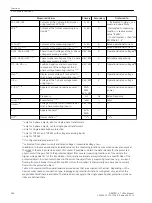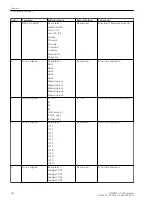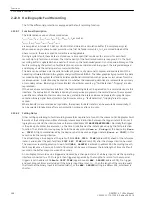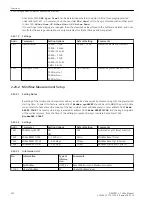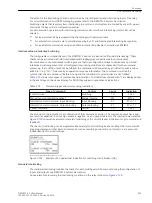
The pickup message follows a configurable time delay. The time delay is necessary when the pickup has to
have time stabilisation. The condition to be monitored should first have sustained a certain minimum time
before further action can be taken. The time delay is also useful when the sensitive reset ration (near 1) is
necessary and therefore sporadic pickup signals should be avoided for measured quantities around the pickup
value. The time delay is usually not necessary (set to 0) for protection tasks, except, if transient conditions
need to be bridged (e.g. increased inrush currents).
The pickup drop-off can be postponed. After clearing the pickup criteria, the pickup signal will be maintained
for this dropout relay time This can be used to monitor the intermittent events, if small gaps are to be bridged
between the threshold transgressions.
If the function is to be triggered, a trip delay will be necessary. This starts with an effective pickup, i.e. after an
approximate time delay. Time delay continues as long as no pickup reset is available, i.e. even during an
approximate dropout relay. This should be considered when a dropout delay has been specified (see also the
setting values in this section).
A trip command once transmitted is retained until the pickup is terminated, if applicable, also via the dropout
delay. The command is retained for all together set minimum tripping times of the tripping functions (address
851
TMin TRIP CMD
, see Section
(Power System Data)).
The dropout ration can be adapted to the requirements. When exceeding a limit value it may only be smaller
than 1, if below then only greater than 1.
Blocking
Every flexible function can be blocked externally from the correspondingly configured binary input. Pickup is
not possible during blocking. A possibly existing pickup will drop off. Delay times as well as dropout relay are
reset.
Internal blocking is activated when, e.g. the measured quantities lie outside the function working area, as well
as for internal faults (hardware, software).
Monitoring of measured quantities can also lead to blocking of flexible functions. One can chose if a function,
which reacts to voltage processing (voltage or power), should have an internal blocking at a secondary meas-
uring voltage failure. Voltage failure can be signalled by the circuit breaker for voltage transformers, via the
binary input
>FAIL:Feeder VT
(FNo. 361) as well as recognised by an internal voltage monitoring (“Fuse
Failure Monitor”, see Section
2.19.1 Measurement Supervision
).
For a function that reacts to current processing (current or power), you can chose if the function should be
blocked for an indicated wire break in the secondary current of the affected measuring location.
Additional Possibilities of Intervention
Last but not least, you can influence a flexible function by logically interlinking own signals with other internal
ones, or by signals that are externally coupled via binary inputs. The link can be created through the userdefin-
able logic functions (CFC).
Blocking an overcurrent time protection time function can thus be done after detection of inrush currents. The
detection of inrushes is functional part of the time overcurrent protection, as per Section
rent Protection for Phase Currents
A dynamic cold load pickup can be achieved by twice creating a flexible protective function (time overcurrent
protection) with different pickup values. Depending on the dynamic cold load pickup according to Section
2.6 Dynamic Cold Load Pickup for Time Overcurrent Protection
one of the functions is released and the other
one blocked.
You can combine overcurrent, undercurrent, direction and task frequency of the network decoupling or for
load shedding. Criteria for under and overexcitation or reactive power control can be derived from reactive
power measurement.
Setting Notes
General
General Flexible functions can be created only with a PC using DIGSI. Up to 12 flexible functions for protection
or monitoring are available. Each function can be individually configured with the options described below.
2.22.7.2
Functions
2.22 Auxiliary Functions
290
SIPROTEC 4, 7UT6x, Manual
C53000-G1176-C230-5, Edition 09.2016
Содержание SIPROTEC 4 7UT6 Series
Страница 394: ...394 SIPROTEC 4 7UT6x Manual C53000 G1176 C230 5 Edition 09 2016 ...
Страница 482: ...482 SIPROTEC 4 7UT6x Manual C53000 G1176 C230 5 Edition 09 2016 ...
Страница 504: ...504 SIPROTEC 4 7UT6x Manual C53000 G1176 C230 5 Edition 09 2016 ...
Страница 522: ...522 SIPROTEC 4 7UT6x Manual C53000 G1176 C230 5 Edition 09 2016 ...
Страница 528: ...528 SIPROTEC 4 7UT6x Manual C53000 G1176 C230 5 Edition 09 2016 ...
Страница 538: ...538 SIPROTEC 4 7UT6x Manual C53000 G1176 C230 5 Edition 09 2016 ...
Страница 664: ...664 SIPROTEC 4 7UT6x Manual C53000 G1176 C230 5 Edition 09 2016 ...
Страница 666: ...666 SIPROTEC 4 7UT6x Manual C53000 G1176 C230 5 Edition 09 2016 ...
Страница 683: ...Z Zero sequence currents 109 Index SIPROTEC 4 7UT6x Manual 683 C53000 G1176 C230 5 Edition 09 2016 ...
Страница 684: ...684 SIPROTEC 4 7UT6x Manual C53000 G1176 C230 5 Edition 09 2016 ...





